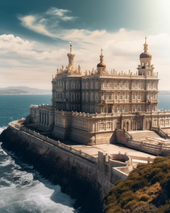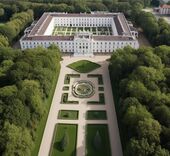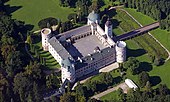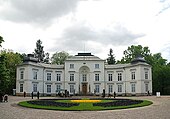List of Palaces, Noble Residence, and Fortresses in Velikoslavia
(Redirected from List of Palaces, Noble Residence, and Fortresses in the Tarsan Empire)
Jump to navigation
Jump to search
This article is incomplete because it is pending further input from participants, or it is a work-in-progress by one author. Please comment on this article's talk page to share your input, comments and questions. Note: To contribute to this article, you may need to seek help from the author(s) of this page. |
Ducal Seats
A Palace is legally defined as any building which is the seat of any noble who holds the rank of Duke or higher. Marqius and lower may not legally title their residences as "palaces" but may use "castle".
| Year Constructed | Palace | Image | Location | Noble residence | Details |
|---|---|---|---|---|---|
| 1745 | Coral Palace | 
|
Levograv | Yes | The Coral Palace was constructed in 1745 as the seat of House Repnin and serves as their primary residence and seat of power in the city. It was constructed in the style of Velikoslavian Baroque, which was in fashion at the time. Construction was expensive and took a significant amount of time and engineering to build a flat stone fortification on Point Vestul in the port of Levograv. The foundation was anchored down into the rock with Latin concrete. The building was construced on two levels on the foundation. A servant level on the lower floors near the foundation where utilities, servants quarters, and the kitchens are located sits under the main level where the Duke's family lives which contains the luxurious areas of the estate. A garden lined road was built to reach the building. The palace is ocean themed in its decoration. |
| 1765 | Sunset Palace | 
|
Ustengrav | Yes | Sunset Palace, or the Palace of the Eternally Rising Sun, was constructed in 1765 by the House of Orlov-Bithynia. It has 300 rooms and is situated on a 100 acre plot of land outside of the city. Around the palace grounds, numerous gardens are maintained. Sometimes called "Little Velikograd", it is known for its resplendent ballrooms and opulent guest rooms. It is known for the old Telerian architecture that adorns the inside. The building hosts several national holidays per year for the Velikograd Court and is a favored venue for aristocratic events. In 1976, the palace was declared a historical site by the Ministry of Culture and receives a monthly stipend towards its upkeep. |
Ducal Palaces
Other palaces owned by Ducal families that aren't seats but still serve the House in some way.
| Year Constructed | Palace | Image | Location | Noble residence | Details |
|---|---|---|---|---|---|
| 1784 | Arcanos Palace | 
|
Delphius | Yes | The Arcanos Palace was constructed as a residence for the Anacomas Family in 1784. The palace was a marvel for its day with over thirty fountains across the grounds as well as an extensive terraced garden complex. The Anacomas Family moved to Marvius in 1927. Currently, the palace is used as a home of Octavian Anacomas. |
| 1823 | Sebatas Manor | 
|
Neapolis | No | Summer retreat of the Kaligoúlas built on the eve of the issue of their Letters Patent. With 45 rooms and an irrigated garden, the palace was constructed with the extensive fortune of the shipping empire of the Kaligoúlas. The building was designed to be unassuming on the outside but adorned with luxury on the inside. In similar style to some ducal seats, the palace relies on long lasting and durable materials such as wood and stone. Carvings etched into the walls and ceiling along with significant amounts of artwork make the palace appealing and warm. Since the rise of House Kaligoúlas to the throne, the grounds were secured better with a stone wall. Modern security systems and other functionality to protect the residents were added in 2010. Sebatas is a favorite of [[Sergios Kaligoúlas], who stays there for most of the year. |
Noble Residences
| Year Constructed | Residence | Image | Location | Details |
|---|---|---|---|---|
| 1423 | Castle Doxia | <imgur w=170>CYNwZFl.jpg</imgur> | Kharios | Castle Doxia is the official Winter House of the Imperial Family. It was constructed initially in 1423 on the site in order to provide defense of the key Ishmalan Pass that guarded access to the sea. It was destroyed in 1486 by a fire and left abandoned until 1508 when it was rebuilt for the first time by the Marchio of Kharios. It served as the seat for the house until 1762 when they moved to an estate residence a few miles away. The castle was converted into a retreat in 1804 and sold to the crown in 1825. It became a favorite retreat of Hadrian II during his reign and later a favorite retreat of Paul of Tarsas of House Keld. Later monarchs continued to use it. In recent months, it has become a favorite place of the heir apparent and his betrothed. |
| 1701 | Ventamos House | 
|
Kios | House of the Count of Kios that was constructed using money that the family gained from aiding in the campaigns against Islam and selling off mining rights to desert lands. Ventamos has 17 rooms that house the members of House Rigas. The courtyard and gardens are comprised of red and white flowering bushes to represent the family colors. A canopy of green protects the courtyard and its accompanying wall from outside view. The house was modernized in first in 1921 and second in 1987, each time successively upgrading the internal facilities. |
| 2008 | Cantaxos Manor | <imgur w=170>Q7Sbv5M.jpg</imgur> | Vinovia | Year round home of the Lord of Veritas. Constructed in 2008 to replace the old manor he inhabited in Eubea by a land grand from the Grand Duke of Vinovia. The Peerage of House Veritas lost its land in 1904 during the revolt of the Bahktar and has been set up on other noble's lands ever since. The manor is a ten bedroom house that sits on a fifteen acre plot of land. Cantaxos Manor was built with the latest smart home technology available and has many features and trappings that have yet to arrive at older buildings. |
Fortresses and Castles
| Year Constructed | Fortress Or Castle | Image | Location | Noble residence | Details |
|---|---|---|---|---|---|
| 1325 | Castra Dasselanos | 
|
Patavium | Yes | Fortified castle built by the Duke of Nicomedia in 1325 as his seat in his territory. When he moved in 1680 to a palace, he kept the castle as a summer home. In 1686, when the first Count of Patavium was issued Letters Patent and swore his vassalship to the Duke, he was granted the castle as a residence. It is still the seat of the family today. |
| 1610 | Forte Salarmo | 
|
Pylos, Tarsas | No | Forte Salarmo was constructed in 1610 outside of Pylos to serve as a defensive fortification to protect the city in the event of an invasion of the key port. With the advent of gunpowder weapons spreading across the world, the fortress was constructed with a significant amount of cannons and sally ports for muskets. |